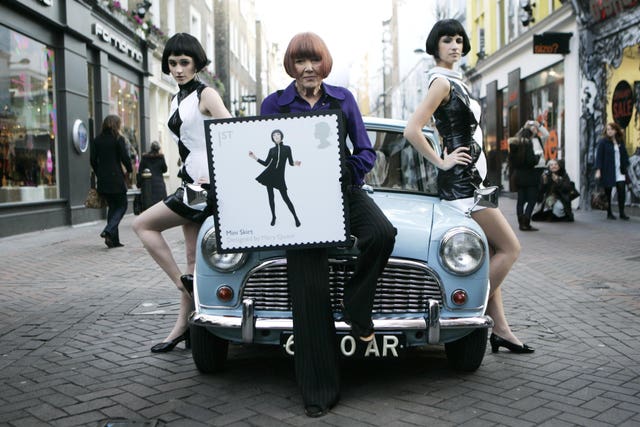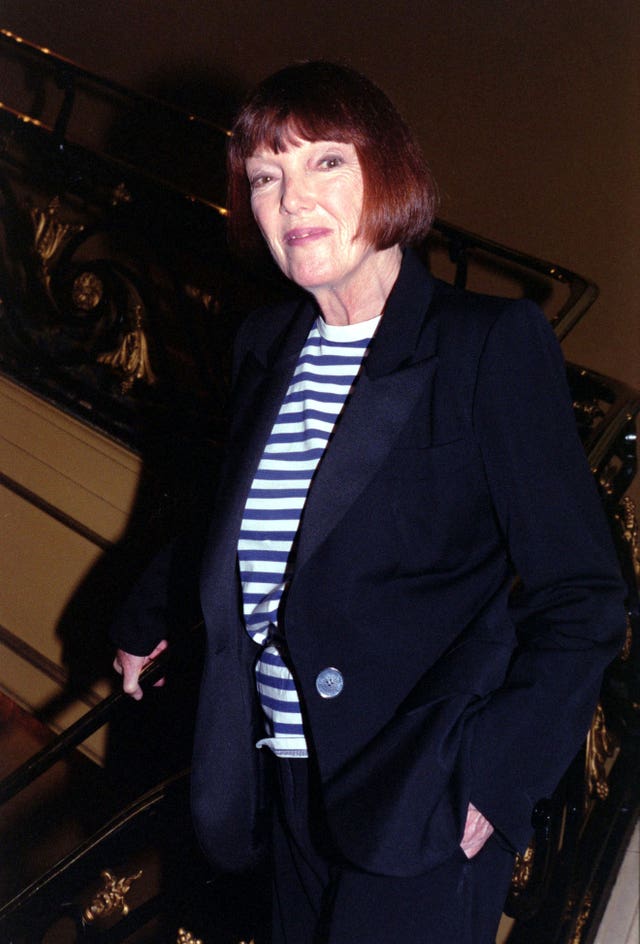Fashion designer Dame Mary Quant, who “democratised fashion and empowered women”, will be remembered for widely being credited with popularising the mini skirt.
As one of the most influential figures in the fashion scene of the 1960s, she was seen as making fashion accessible to the masses with her sleek, streamlined and vibrant designs.
In a statement Dame Mary’s family said she died “peacefully at home in Surrey” at the age of 93 on Thursday.
Her daring designs spread worldwide and, as she put it, liberated young women by giving them “the ability to run for a bus” and although she took credit for inventing the mini skirt, there has always been some dispute as to whether she was the actual pioneer.

However, Dame Mary certainly did more than anybody else to popularise it and, with her “pop art” approach to fashion, brighten up a nation anxious to escape from the austerity of the post-war 1950s.
Born in south-east London on February 11 1930, she was the daughter of two Welsh school teachers.
She gained a diploma in the 1950s in art education at Goldsmiths College, where she met her husband Alexander Plunket Greene, who later helped establish her brand.
Dame Mary was taken on as an apprentice to a milliner before making her own clothes and in 1955 opened Bazaar, a boutique on the King’s Road in Chelsea.
Initially her most lucrative lines were small white plastic collars to brighten up black dresses or a black sweatshirt. Black stretch stockings were popular too.
This was enough for her, and following the success of a pair of “mad house pyjamas” designed for the opening of Bazaar, she decided to embark on her own range of clothing.
At first she worked solo, but such was the success of her imaginative efforts that she was soon employing a handful of machinists. Within 10 years, she was working with 18 different manufacturers concurrently.

Her success was so pronounced that she opened up another location in the no less fashionable London Street, Knightsbridge, and by 1961 she was exporting to the United States.
Dame Mary also developed the coloured and patterned tights which generally accompanied mini skirts and which ultimately were to supersede stockings as routine women’s wear.
To keep up with the huge demand for her fashions, she went into mass production and set up what she called the Ginger Group to boost sales.
She began experimenting with shorter hemlines in the late 1950s, culminating in the creation of one of the defining fashions of the following decade.
Although others claimed to be the inventors of the mini skirt, it was Dame Mary who was not only the power behind its development but who also gave it its name – after her favourite make of car, the Mini.
In 2014, Dame Mary recalled its “feeling of freedom and liberation”.

She said: “It was the girls on King’s Road who invented the mini. I was making clothes which would let you run and dance and we would make them the length the customer wanted.
“I wore them very short and the customers would say, ‘shorter, shorter’.”
Other styles from the 1960s included Peter Pan collars, as well as knitwear, swimwear and accessories and garments made using Butterick patterns and the “dangerously short” micro-mini skirt, as well as “paint box” make-up and plastic raincoats.
By then she was being described as “the leading fashion force outside Paris”, while the columnist Bernard Levin called her the “high priestess of Sixties fashion”.
Dame Mary also revolutionised the high street with hot pants, and trousers for women, as well as accessories, tights and make-up, while using the daisy brand design that became synonymous with her creations.
Her clothes were popularised by Jean Shrimpton, Pattie Boyd, Cilla Black and Twiggy.
In 1988, she designed the interior of her beloved Mini 1000 motor car.
She resigned as director of Mary Quant Ltd, her cosmetic company, 12 years later after a Japanese buyout and there were soon more than 200 Mary Quant Colour shops in Japan.

Dame Mary, who was also a Fellow of the Chartered Society of Designers and winner of the Minerva Medal, the society’s highest award, was made an OBE in 1966 for services to the fashion industry.
In 2014, she was made a dame for services to British fashion in the Queen’s New Year list.
She said at the time: “I am absolutely delighted to have been awarded this terrific honour. It is extremely gratifying that my work in the fashion industry has been recognised and acknowledged in such a significant way.”
In 2020, an exhibition at the Victoria and Albert Museum about Dame Mary’s fashion proved a hit with the public.
It was visited 400,000 times and was said at the time to be the third most visited fashion exhibition in the museum’s history after Christian Dior: Designer Of Dreams and Alexander McQueen: Savage Beauty.
The exhibition showcased more than 120 garments, the majority of which had never been on display before, as well as accessories, cosmetics, sketches and photographs.
It also toured in Australia, Scotland and New Zealand.
It revealed how Dame Mary “democratised fashion and empowered women” with her minimal and androgynous graphic look, which rejected the “debutante” styles of previous generations.
Ever wish you could wear Mary Quant designs?
You can! (And its easier than you think… 👀)
Download our free sewing pattern, inspired by Mary Quant's iconic A-line mini dress, and create your own. https://t.co/3fgClYZ5UF pic.twitter.com/RJZc4H4usB
— V&A (@V_and_A) August 4, 2021
In 2021, actress and film producer Sadie Frost created a fashion documentary about Dame Mary called Quant.
Contributions to the biographical film came from prominent figures in the world of fashion, such as supermodel Kate Moss, designer Dame Vivienne Westwood, beauty entrepreneur and make-up artist Charlotte Tilbury, designer Jasper Conran and designer Dame Zandra Rhodes.
Frost said Dame Mary “changed the whole kind of female silhouette” and stopped women dressing like their mothers by creating “free and daring” designs.
In 2022, Taipei Fine Arts Museum in Taiwan also exhibited Mary Quant: Fashion Revolutionary.
She was appointed a member of the Order of the Companions of Honour in the 2023 New Year Honours list for services to fashion.
The special award, granted to those who have made a major contribution to the arts, science, medicine or government, was founded on June 4 1917 by George V.
It is sometimes regarded as the junior honour to the Order of Merit and is made up of the sovereign, plus no more than 65 members, who may use the letters CH after their names.
Dame Mary joined an illustrious list of recipients including broadcaster Sir David Attenborough, actress Dame Judi Dench, former Beatle Sir Paul McCartney and musician Sir Elton John.




Comments: Our rules
We want our comments to be a lively and valuable part of our community - a place where readers can debate and engage with the most important local issues. The ability to comment on our stories is a privilege, not a right, however, and that privilege may be withdrawn if it is abused or misused.
Please report any comments that break our rules.
Read the rules here